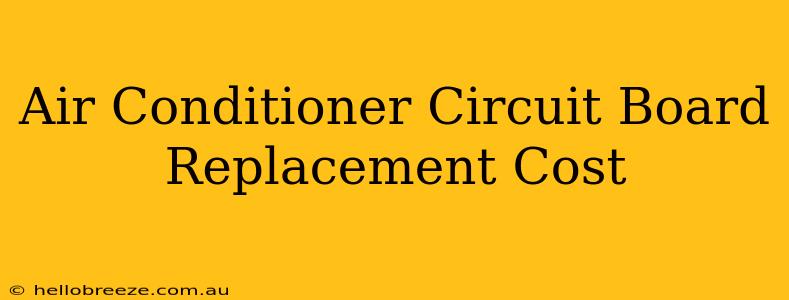Replacing an air conditioner's circuit board can be a significant expense, but understanding the factors influencing the cost is crucial for budgeting and making informed decisions. This guide breaks down the various elements that contribute to the overall price, helping you navigate this potential repair.
Factors Affecting Air Conditioner Circuit Board Replacement Cost
Several factors determine the final cost of replacing your AC's circuit board. Let's delve into the key contributors:
1. The Type of Air Conditioner:
The type of AC unit significantly impacts the cost. Replacing a circuit board in a window unit will generally be cheaper than replacing one in a complex central air conditioning system. Window units usually have simpler, more readily available boards. Central AC systems, however, often require more specialized boards and potentially more labor. Heat pumps, with their added functionality, might also fall into a higher price bracket.
2. The Brand and Model:
Brand-name AC units often command higher prices for replacement parts. Finding a compatible circuit board for an older or less common model can also drive up the cost, as availability might be limited. The complexity of the board itself, specific to the model, plays a role as well. Some models use highly specialized components that are more expensive to source.
3. The Cost of the Circuit Board:
The price of the circuit board itself varies greatly. Generic replacement boards might be more affordable, but OEM (Original Equipment Manufacturer) boards are generally preferred for optimal compatibility and performance. OEM boards usually come with a warranty, adding a degree of security. However, the cost of an OEM board can be substantially higher.
4. Labor Costs:
Labor costs are a substantial part of the overall expense. The technician's hourly rate, the complexity of the installation (requiring specialized tools and expertise), and the time needed to replace the board all influence labor charges. Diagnosing the problem before replacing the board also adds to the labor cost. In some cases, a faulty board might be misdiagnosed, leading to unnecessary expenses.
5. Additional Repairs:
Sometimes, a faulty circuit board isn't the sole problem. Underlying issues might have caused the board to fail in the first place. Discovering and repairing these secondary problems adds to the overall cost. It is always wise to ensure a thorough diagnostic assessment before committing to repairs.
Estimating the Cost: A Range of Possibilities
The cost can range significantly. A simple replacement for a window unit might cost between $100 and $300, including parts and labor. However, a central AC system repair could easily range from $300 to $800 or more. In extreme cases involving specialized boards and extensive troubleshooting, costs can rise even higher.
Tips for Saving Money
-
Get Multiple Quotes: Obtain quotes from several HVAC technicians before making a decision. This allows for comparison and helps you identify the best value.
-
Consider DIY (Do It Yourself): For individuals with some electrical experience and confidence, replacing a circuit board in a simple system might be a feasible DIY project. However, improper installation can lead to further damage or safety hazards, so proceed with caution.
-
Check for Warranties: If your AC system is still under warranty, a faulty circuit board might be covered by the manufacturer. Contact them before initiating any repairs.
Conclusion: Informed Decisions for Your Air Conditioner
Replacing an AC circuit board can be a costly undertaking, but a clear understanding of the cost factors empowers you to make informed decisions. By carefully considering the type of system, brand, and potential additional repairs, you can budget effectively and ensure a smooth repair process. Remember to always prioritize professional help for complex repairs and for safety reasons.

